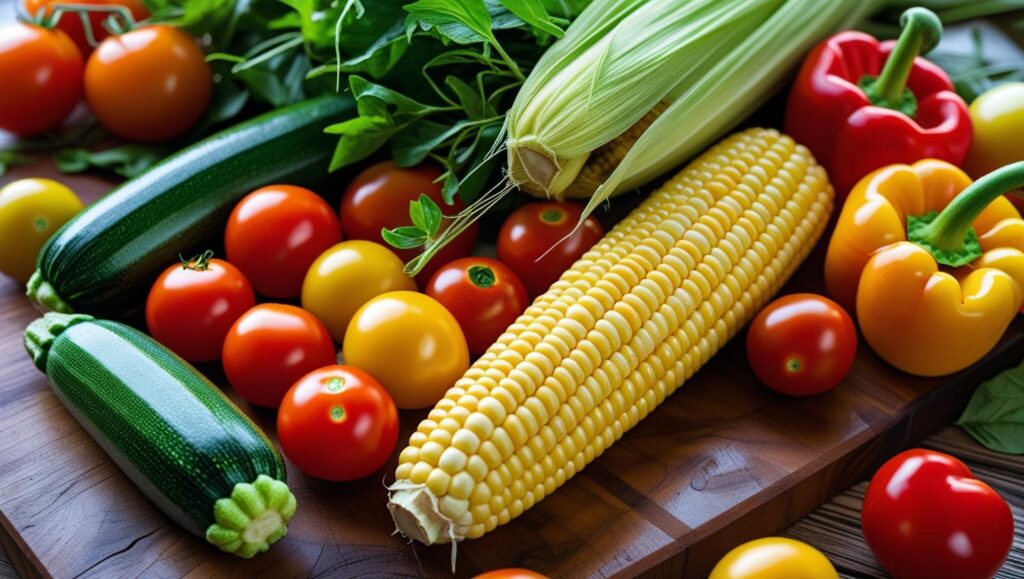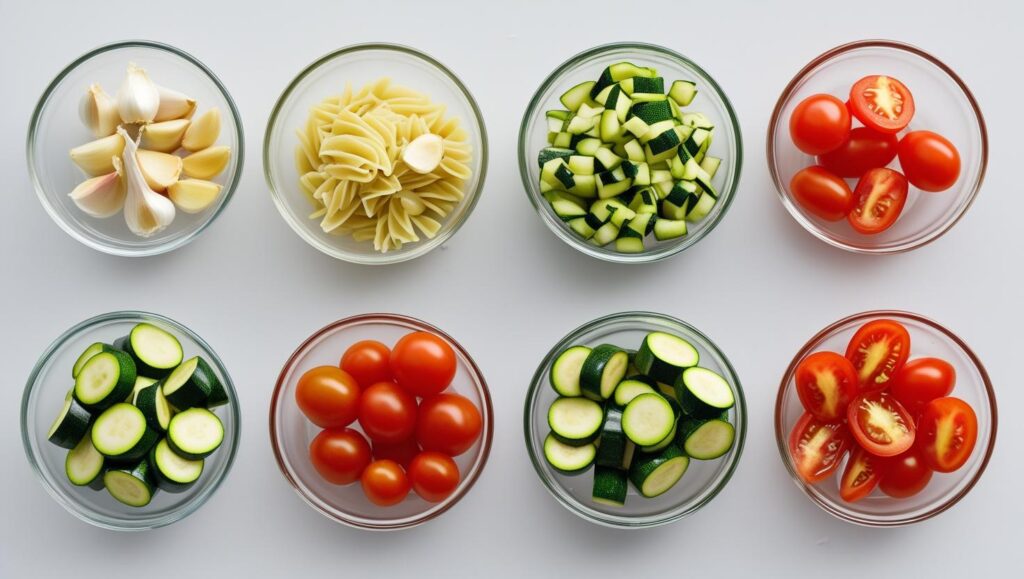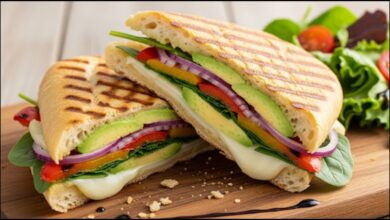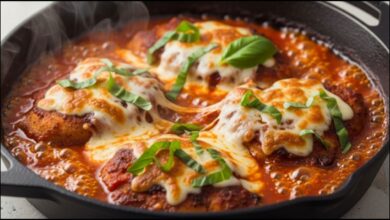There’s a special kind of joy that comes from walking through a farmer’s market on a sunny morning. The stalls are overflowing with colorful vegetables, and you can’t help but fill your bag with a little bit of everything. But then you get home, look at your beautiful haul, and think, “Now what?”
I’ve been there more times than I can count. That’s why I developed this Farmer’s Market Pasta. It’s not just a recipe; it’s a simple, reliable method for turning that glorious assortment of fresh produce into a stunning and delicious meal in about 30 minutes. It’s the perfect answer to a busy weeknight and my absolute favorite way to celebrate the season.
This dish is all about light, bright flavors and textures that sing of summer. We’ll be creating a simple, glossy sauce that coats every piece of pasta and vegetable without weighing them down. Forget heavy creams or long-simmering sauces; this is freshness in a bowl.
Quick Recipe
- Preparation Time:
15M - Cooking Time:
20M - Total Time:
35M - Type of dish: Main Course
- Cuisine: Italian-American
- Recipe Yield: 4 servings
- Calories: 460 kcal (estimated)
Why This Recipe Is a Game-Changer
| Takeaway | Description |
| Infinitely Customizable | Use any combination of fresh vegetables you find. This recipe is a template for success. |
| Ready in 30 Minutes | A perfect, well-rounded meal for those busy weeknights. |
| Highlights Fresh Ingredients | Simple techniques let the peak-season flavor of your vegetables shine through. |
| Creates a Perfect Sauce | Learn the secret to a light, yet silky sauce using starchy pasta water—no heavy cream needed! |
What Makes This Farmer’s Market Pasta So Special?
At its heart, this is a summer vegetable pasta that truly respects the ingredients. Our goal isn’t to mask the flavors of those beautiful vegetables but to amplify them. We do this by cooking them smartly and creating a “sauce” from just a few simple, high-quality pantry staples: good olive oil, garlic, and the most important ingredient of all—starchy pasta water.
I call this my “no-recipe recipe” because once you learn the basic technique, you can adapt it to whatever the market offers, from spring asparagus and peas to late-summer zucchini and tomatoes. It’s a dish that celebrates flexibility and empowers you to be creative in the kitchen.

The Heart of the Dish: Choosing Your Vegetables
This is where the fun begins! The key to a perfectly cooked Farmer’s Market Pasta is understanding that not all vegetables cook at the same rate. To avoid a mushy mess, we add them to the pan in stages.
Here’s my simple guide for grouping your veggies:
- Hard & Hearty (Go in first): These need a head start to become tender. Think of things like chopped carrots, fennel, bell peppers, or thick asparagus stems.
- Quick-Cooking (Add in the middle): These don’t need as long to cook through. This group includes zucchini, yellow squash, corn kernels, broccoli florets, and tender asparagus tips.
- Tender & Delicate (Add at the very end): These barely need to be cooked at all. They just need a little heat to wilt or release their juices. This is for your cherry tomatoes, spinach, arugula, and most fresh herbs.
Don’t feel overwhelmed by these categories! Just a little planning is all it takes to ensure every vegetable is perfectly tender-crisp.
Essential Ingredients for Your Pasta
While the vegetables are the star, a few key pantry items build the foundation of flavor.
- Pasta: You’ll want about 8 ounces of dried pasta. I love shapes with nooks and crannies that catch the sauce and small bits of vegetables, like orecchiette, fusilli, or medium shells.
- Good Olive Oil: We use it for cooking and for finishing, so choose a quality extra-virgin olive oil with a flavor you enjoy.
- Aromatics: Two or three cloves of thinly sliced garlic are a must. I also love using a finely chopped shallot for a milder, more delicate onion flavor. A pinch of red pepper flakes adds a lovely warmth.
- The “Sauce” Liquid: A splash of dry white wine (like a Pinot Grigio) or fresh lemon juice is fantastic for deglazing the pan (I’ll explain this later!).
- Starchy Pasta Water: This is the free, magical ingredient that brings everything together. Don’t throw it away!
- The Finishers: A generous amount of freshly grated Parmesan cheese, a big handful of chopped fresh herbs (basil, parsley, or mint are all wonderful), and a final drizzle of olive oil.
Tools You’ll Need
- A large pot (for cooking pasta)
- A large skillet or sauté pan
- Colander or spider strainer
- Sharp knife and cutting board

How to Make the Perfect Farmer’s Market Pasta: A Step-by-Step Guide
Ready? Let’s walk through this together. It’s easier than you think.
Step 1: Prep Your Ingredients
This is what chefs call mise en place, or “everything in its place.” Before you even turn on the stove, wash and chop all your vegetables, mince your garlic, and grate your cheese. Cooking will be much more relaxed and enjoyable this way, I promise.
Step 2: Get the Pasta Water Ready
Fill a large pot with water and bring it to a rolling boil. Now, for a crucial step: season the water with salt. You want it to taste “salty as the sea.” This seasons the pasta from the inside out and is the first layer of flavor for your finished dish.
Step 3: Sauté the Vegetables in Stages
While the water is heating, place your large skillet over medium heat and add a good glug of olive oil.
- First, add your “Hard & Hearty” vegetables. Sauté for 4-5 minutes until they start to soften.
- Next, add the “Quick-Cooking” vegetables. Continue to sauté for another 3-4 minutes.
- Finally, add the aromatics. Stir in your sliced garlic and red pepper flakes (if using) and cook for just one minute more until fragrant. Be careful not to let the garlic burn!
Step 4: Cook the Pasta
Once your water is boiling, add your pasta. Cook according to package directions until it’s al dente. This means it should still have a slight, firm bite in the center. It will finish cooking in the skillet, so undercooking it slightly is better than overcooking it. Before you drain, reserve at least 1-2 cups of the starchy pasta water.
Step 5: Create the Pan Sauce
Turn the heat on your skillet with the vegetables up to medium-high. Add a splash of white wine or lemon juice. It will sizzle and steam—this is a good thing! Use your spoon to scrape up any browned bits from the bottom of the pan. This is called deglazing, and those browned bits are packed with flavor.
Step 6: Bring It All Together (The Magic Step)
Using a spider strainer or tongs, transfer your cooked pasta directly from the pot into the skillet with the vegetables. Don’t worry if some water comes with it. Now, add about 1/2 cup of the reserved pasta water to the skillet.
Stir and toss everything together vigorously. You will see the starchy water, olive oil, and cheese begin to combine into a light, glossy sauce that clings perfectly to the pasta. This is called emulsifying, and it’s the secret to an amazing healthy pasta dish without any cream. If it looks a little dry, just add another splash of pasta water until it’s the perfect consistency.
Step 7: Finish with Flavor
Turn off the heat. Add your “Tender & Delicate” vegetables like cherry tomatoes and spinach now—the residual heat will cook them perfectly. Stir in the grated Parmesan cheese and fresh herbs. Give it one last toss, taste, and adjust your seasoning with salt and pepper if needed. Serve immediately with an extra drizzle of olive oil and more Parmesan on top.
A Recipe to Make Your Own
This Farmer’s Market Pasta is more than just a meal; it’s a celebration of freshness and simplicity. It’s a dish that proves you don’t need complicated techniques or heavy ingredients to create something truly special. I hope you embrace the method, get creative with your market finds, and make this recipe a staple in your own kitchen.
Happy cooking!
Giada De Laurentiis’ Viral Dessert Transforms Pasta into a 2-Ingredient Summer Treat

 The Ultimate Filipino Fried Chicken Recipe for Crispy, Juicy Perfection
The Ultimate Filipino Fried Chicken Recipe for Crispy, Juicy Perfection Unlock Flavor: How to Make the Perfect Avocado Veggie Panini Every Time
Unlock Flavor: How to Make the Perfect Avocado Veggie Panini Every Time The Easiest Weeknight Chicken Pizzaiola Dish You’ll Ever Make
The Easiest Weeknight Chicken Pizzaiola Dish You’ll Ever Make The Secret to a Perfectly Healthy Homemade Palak Paneer
The Secret to a Perfectly Healthy Homemade Palak Paneer